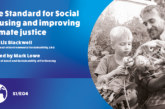L&Q has today published its Fixed Term Tenancy (FTT) research as it begins converting 6000 residents onto assured tenancies. It has published the report to share their findings with other housing associations in a bid to encourage more security in social housing.
The social housing provider is delivering on its promise to provide more security to its social rented residents and has now written to residents to give them the option of switching to assured tenancies. L&Q has also established a new five-person team (pictured) to ensure the conversions are smooth and efficient for residents.
L&Q announced plans to abolish FTTs last September to provide more security for their residents. In November it started offering assured tenancies to all new residents and committed to converting the majority of its social rented fixed term tenants by April 2019.
L&Q is also looking at other areas where the existing system can be improved to make it easier for residents to move.
Several other housing associations have expressed interest in following L&Q’s lead in retiring FTTs since their initial announcement, and L&Q is publishing its research to share its experiences and help guide others through the process.
FTTs were introduced as part of the Localism Act in 2011 by the government to “create a more flexible system so that scarce public resource can be focused on those who need it most.” However, the L&Q report concluded that the underlying problems that the FTTs were intended to solve “hadn’t gone away” and instead recommended they be tackled by “effective housing management practices within the framework of open-ended assured tenancies and a degree of service innovation.”
Some of the benefits of assured tenancies for residents are being able to move more easily through mutual exchange and improving or altering their home without permission.
Andy Brown, Chief Operating Officer at L&Q, said: “We want our tenants to feel that they have a quality, affordable home for life. We know that abolishing Fixed Term Tenancies is only a small part of the challenge, and there is still work to be done to ensure that we are doing our best by our residents. We want to work with other like-minded organisations in the sector to find more solutions to issues such as mobility. One of our next steps is to examine how to make the most of our existing stock and support residents who want to find properties that are the right size and in the right location.”









